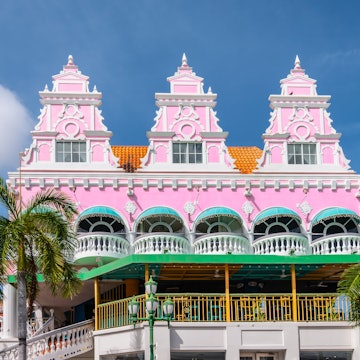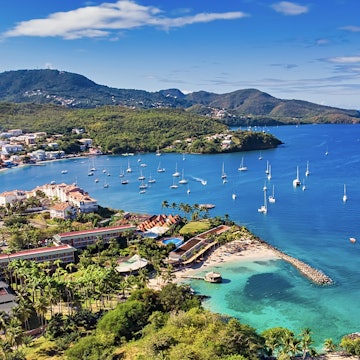
Carnival – a festive season that typically includes parades and public street parties – is serious business in the Caribbean. The saying here goes that the party lasts year-round: eight months preparing and partying in anticipation, a month actually celebrating, followed by a period of blissful recovery and recollection.
Unlike the rest of the world where carnivals are typically held in February (the most famous of which are in Venice and Rio, as well as Mardi Gras in New Orleans – which has many Caribbean roots), visitors to the Caribbean can find a carnival at almost any time of year. Islands such as Trinidad and Dominica where the original colonists were Catholics tend to keep their carnivals on the traditional schedule, meaning they climax in the pre-Lenten period before Ash Wednesday, usually around February. But elsewhere, local festivals like the July Harvest Festival (www.harvestfestivals.net) on the former British colony of Barbados have morphed into huge events with all the trappings of carnival.
No matter the name or origin, all of these explosions of creative energy share raucous dance, pounding music and flamboyant costumes that combine into one heaving, sweaty orgy of color and sound. And while Caribbean carnivals share much, each has its own flavour. You will need to visit many – if not all – to get the complete picture of what is always the main event on each island's calendar.
Visitors are welcome at all these events and you can fully expect to be swept up in frenetic, hectic riot of it all. So pick your month, pick your carnival and enjoy the celebration.
February
Trinidad has one of the world's largest carnivals (www.ncctt.org). The celebrations begin up to eight months in advance, with costumes becoming more elaborate and spectacular every year and hundreds of calypso bands preparing their music. Easily the pulsing heart of Caribbean carnival creativity, the island’s sounds are constantly evolving -- you may hear booming rapso (a mixture of calypso and rap) or the latest variation on soca (the ubiquitous carnival sound that started on Trinidad 50 years ago and combines calypso, soul and African among many other influences). It is a huge honour (and a large cash prize) to be named the Calypso Monarch, the person chosen in national judging for their musical performances.
Affluent Aruba’s local music tradition is also a focus of its carnival celebration. Parades last for about four weeks before Ash Wednesday, with the entire island thronging in the capital, Oranjestad, for the Grand Parade on the Tuesday before Ash Wednesday. The parade includes the ritual midnight burning of an effigy of King Momo, a bad spirit. Most carnivals throughout the Caribbean, even the ones most closely linked to religious traditions, have a component of old African mysticism and often involve the exorcising of evil spirits.
All the French-speaking islands celebrate carnival for at least five days before Ash Wednesday, and St-Barthélemy has one of the best around. It has all the expected parades, music competitions, pageants – but because of the island's small size, the festivities are all-pervasive. Here, King Carnival is the name given to the evil spirit and he goes up in smoke on beautiful Shell Beach.
April
Jamaica's carnival celebrates the island's world-famous music and is inspired by Trinidad's. On Easter, bands from across the region converge in the capital, Kingston, for festivals that start on the beaches and parade through the streets. The main event, Bacchanal Jamaica, is a music blow-out stretching over many weeks.
July
Back in the 17th Century when Barbados was largely British sugar plantations, the slaves and locals began celebrating the cane harvest with the appropriately named Crop Over Festival in late July and early August. Over the years it has become a proper carnival, the second-largest in the Caribbean after Trinidad's. Calypso band competitions begin in mid-July and peak on the first Monday in August, called Kadooment Day (Bajan slang for 'big commotion'), when Barbados is one big party.
Once an island of carnival mania, the celebrations in Cuba became muted in the early 1960s – with the notable exception of island's second city Santiago de Cuba, which throws a bash every July 25 that's as good as any despite official efforts to discourage it. The spirit and vigor are raw, and you sense island-wide carnival energies just below the surface waiting to explode should change come to Cuba.
Sint Eustatius may be small, but its carnival is not (www.statiatourism.com). Like many islands, it has a midnight-to-dawn parade that ends with the burning of an effigy – here charmingly called Prince Stupid – to rid the island of evil. Given the island only has 3400 inhabitants, this carnival is almost one-big family reunion. It erupts over the last week of July.
The carnival on the island of St Lucia is one of the Caribbean's largest, as seemingly every one of the 170,000 islanders has a vital role to play in the festivities, which start in late May. The capital Castries shuts down during the third week of July so it can explode in color, song, dance and non-stop revelry.
August
In Antigua, the abolition of slavery on 1 August 1834 is the root of this suitably free-spirited bash which reaches its wild peak on the first Tuesday in August (www.antiguacarnival.com). Like other carnivals, music is a key component, but on Antigua there is even more of an emphasis on entertaining the jubilant masses island-wide. Bands of all sizes thread their way around the island visiting villages big and small to party before heading to the capital, St John’s, for the final explosion.
December
Junkanoo, as the party is called in the Bahamas, has its roots in secret West African societies before slavery. Now a fully-fledged carnival in terms of music, dance, colour and costumes, it kicks off on Boxing Day (26 December) for a short and frenzied swirl of parties and parades that culminate on New Year’s Day (1 January). Personal 'floats' worn by one person and weighing up to 90kg vie for prizes and star in parades in the capital, Nassau. Another event, the Junkanoo Carnival (bahamasjunkanoocarnival.com), has been launched by the local tourist industry and is held in May.
This article was first published in July 2012 and updated in March 2015.














